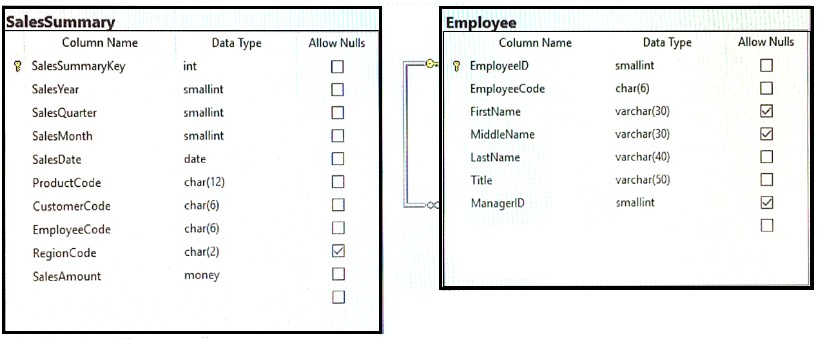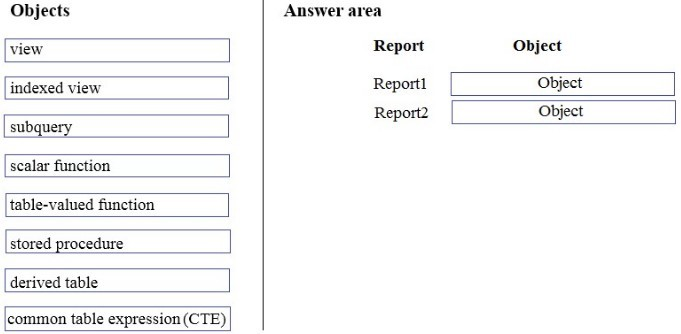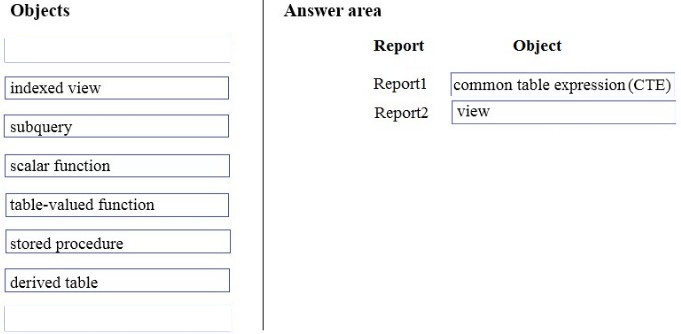

DRAG DROP -
Note: This question is part of a series of questions that use the same scenario. For your convenience, the scenario is repeated in each question. Each question presents a different goal and answer choices, but the text of the scenario is exactly the same in each question in this series.
Start of repeated scenario -
You have a database that contains the tables shown in the exhibit. (Click the Exhibit button.)
You review the Employee table and make the following observations:
✑ Every record has a value in the ManagerID except for the Chief Executive Officer (CEO).
✑ The FirstName and MiddleName columns contain null values for some records.
✑ The valid values for the Title column are Sales Representative manager, and CEO.
You review the SalesSummary table and make the following observations:
✑ The ProductCode column contains two parts: The first five digits represent a product code, and the last seven digits represent the unit price. The unit price uses the following pattern: ####.##.
✑ You observe that for many records, the unit price portion of the ProductCode column contains values.
The RegionCode column contains NULL for some records.
✑ Sales data is only recorded for sales representatives.
You are developing a series of reports and procedures to support the business. Details for each report or procedure follow.
Sales Summary report: This report aggregates data by year and quarter. The report must resemble the following table.
Sales Manager report: This report lists each sales manager and the total sales amount for all employees that report to the sales manager.
Sales by Region report: This report lists the total sales amount by employee and by region. The report must include the following columns: EmployeeCode,
MiddleName, LastName, RegionCode, and SalesAmount. If MiddleName is NULL, FirstName must be displayed. If both FirstName and MiddleName have null values, the world Unknown must be displayed/ If RegionCode is NULL, the word Unknown must be displayed.
Report1: This report joins data from SalesSummary with the Employee table and other tables. You plan to create an object to support Report1. The object has the following requirements:
✑ be joinable with the SELECT statement that supplies data for the report
✑ can be used multiple times with the SELECT statement for the report
✑ be usable only with the SELECT statement for the report
✑ not be saved as a permanent object
Report2: This report joins data from SalesSummary with the Employee table and other tables.
You plan to create an object to support Report1. The object has the following requirements:
✑ be joinable with the SELECT statement that supplies data for the report
✑ can be used multiple times for this report and other reports
✑ accept parameters
✑ be saved as a permanent object
Sales Hierarchy report: This report aggregates rows, creates subtotal rows, and super-aggregates rows over the SalesAmount column in a single result-set. The report uses SaleYear, SaleQuarter, and SaleMonth as a hierarchy. The result set must not contain a grand total or cross-tabulation aggregate rows.
Current Price Stored Procedure: This stored procedure must return the unit price for a product when a product code is supplied. The unit price must include a dollar sign at the beginning. In addition, the unit price must contain a comma every three digits to the left of the decimal point, and must display two digits to the left of the decimal point. The stored procedure must not throw errors, even if the product code contains invalid data.
End of Repeated Scenario -
You are creating the queries for Report1 and Report2.
You need to create the objects necessary to support the queries.
Which object should you use to join the SalesSummary table with the other tables that each report uses? To answer, drag the appropriate objects to the correct reports. each object may be used once, more than once, or not at all. You may need to drag the split bar between panes or scroll to view content.
Select and Place:


safiullah
Highly Voted 5 years, 10 months agoBillybob0604
4 years, 5 months agoprakash101179
Highly Voted 5 years, 9 months agoKiruu23
Most Recent 4 years, 10 months agoAnette
5 years, 1 month agoAnette
5 years, 1 month agoJiacheng
5 years, 4 months agoJiacheng
5 years, 4 months agoBarbedx
5 years, 4 months agoanonimdom
5 years, 5 months agoBarbedx
5 years, 4 months agoBenAsare
5 years, 7 months ago